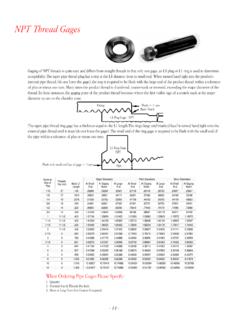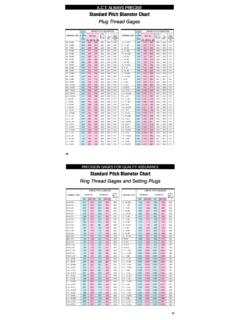Transcription of Mounting Strain Gages - nakka-rocketry.net
1 Title: Mounting Strain Gages Author: Revision: (June 2002) 1 Mounting Strain Gages TO THE LOAD CELL BODY Mounting Strain Gages to the load cell body is not a difficult task if the following suggested procedure is followed. It is important to recognize that the Strain Gages are delicate and can easily be damaged if incorrectly handled or mounted. Most importantly, the solder pads will break off if Strain relief is not provided, as described in the instructions below. Strain gage Figure and Definitions Figure 1 Strain gage Tools & supplies required 1. Soldering iron with pointed tip (preferably new tip) 2.
2 Illuminated magnifier (optional, but recommended) 3. Electrical grade Solder 4. Rosin soldering flux 5. Epoxy adhesive 6. Cyanoacrylate adhesive (optional) 7. Lacquer thinner, acetone or alcohol 8. Masking tape 9. Toothpicks 10. Tweezers 11. Awl 12. Ruler 13. Fine gauge tinned-copper lead wires (30 awg wire-wrap wire works well) 14. Ohmmeter Title: Mounting Strain Gages Author: Revision: (June 2002) 2 Positioning Strain Gages The correct positioning and orientation of the Strain Gages is important. Figure 2 shows the orientation and positioning for 1, 2 or 4 gage (full bridge) configuration.
3 The arrows represent the gage grid line orientation. (Note that for the 4 gage configuration, the 2 transverse Gages may be mounted at any convenient location on the load cell body, but must be oriented transversely). One gage (longitudinal) Two Gages (2 longitudinal) Four Gages (2 longitudinal, 2 transverse) Figure 2 Positioning and orientation of Gages Mounting Strain Gages 1. Using the awl, lightly etch a line across the side of the load cell body at the exact height of the hole centre, as shown in Figure 3. Etched line Figure 3 2. Clean the Mounting area with lacquer thinner, acetone or methyl alcohol.
4 3. Using tweezers, place the Strain gage (s) in position FOIL SIDE UP. Align the longitudinal gage (s) such that the grid centre alignment marks line up with the etched line. Never touch the Gages with your fingers. 4. For the 4 gage arrangement, similarly position the two transverse Gages above and below the other two. The exact location of these Gages is not important, Title: Mounting Strain Gages Author: Revision: (June 2002) 3but it is important that they are aligned in the transverse direction. See Figure 4a. 5. Cut off a strip of masking tape, and carefully position the tape over the Gages .
5 Press the tape down onto the load cell body, making sure that the Gages do not become disoriented. See Figure 4b. 6. Next, lift off one end of the tape such that the Gages are exposed. Leave the other end attached to the load cell body. This is illustrated in Figure 4c. Figure 4a Figure 4b Figure 4c Title: Mounting Strain Gages Author: Revision: (June 2002) 4 7. Using a toothpick, apply a minimal amount of epoxy adhesive (or cyanoacrylate) to the underside of each gage . Take care not to apply excessive adhesive. 8. Carefully re-apply the masking tape to the load cell body. Press firmly down over each Strain gage , squeezing out any excess adhesive.
6 9. Allow the adhesive to cure fully, then remove the masking tape. 10. Strip 2 mm of insulation from the lead wires. Place stripped ends of lead wires onto the solder pads, then use a piece of cellophane tape to hold lead wires in place. Place the tape strip as shown in Figure 5. align edge of tape to edge of gage Lead wires Epoxy Figure 5 11. Apply a small amount of epoxy to bond the lead wires to the body of the load cell, as shown in Figure 5. This serves to provide Strain relief such that movement of the wires will not induce Strain (stress) to the Strain gage solder pads (after the wires are soldered to the pads).
7 12. Make certain the epoxy does not flow along the lead wires (capillary action) such that it reaches the solder pads. Allow the epoxy to fully cure before proceeding to the next step. 13. Gently remove the cellophane tape. Make sure the lead wire ends remain in contact with the solder pads. Using a toothpick, dab a small amount of rosin flux onto the solder pads and wire. 14. Allow the soldering gun to reach operating temperature. Make sure the gun tip is clean (no oxide). Apply a small amount of solder onto the gun tip. 15. Briefly touch the gun tip against the wire. Solder will immediately flow onto the wire and solder pads, forming a tiny solder mound, as shown in Figure 6 Title: Mounting Strain Gages Author: Revision: (June 2002) 5 Figure 6 - 16.
8 Using an ohmmeter, confirm the resistance for each gage is 350 1 ohm. 17. Using alcohol (not lacquer thinner or acetone) and a cloth or paper towel, carefully clean away any excess solder flux. 18. Apply a thin layer of epoxy over the entire Strain gage to provide environmental protection.





